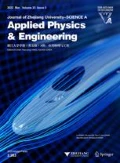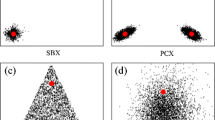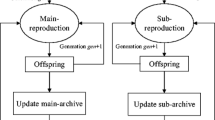Abstract
Through the transformation of hydraulic constraints into the objective functions associated with a water supply network rehabilitation problem, a non-dominated sorting Genetic Algorithm-II (NSGA-II) can be used to solve the altered multi-objective optimization model. The introduction of NSGA-II into water supply network optimal rehabilitation problem solves the conflict between one fitness value of standard genetic algorithm (SGA) and multi-objectives of rehabilitation problem. And the uncertainties brought by using weight coefficients or punish functions in conventional methods are controlled. And also by introduction of artificial inducement mutation (AIM) operation, the convergence speed of population is accelerated; this operation not only improves the convergence speed, but also improves the rationality and feasibility of solutions.
Similar content being viewed by others
References
Alvisi, S., Franchini, M., 2006. Near-optimal rehabilitation scheduling of water distribution systems based on a multi-objective genetic algorithm. Civil Engineering and Environmental Systems, 23(3):143–160. [doi:10.1080/10286600600789300]
Deb, K., 2001a. Multi-objective Optimization Using Evolutionary Algorithms. Wiley, Chichester, UK.
Deb, K., 2001b. Nonlinear goal programming using multi-objective genetic algorithms. Journal of the Operational Research Society, 52(3):291–302. [doi:10.1057/palgrave.jors.2601089]
Deb, K., Pratap, A., Agarwal, S., Meyarivan, T., 2002. Fast and elitist multi-objective Genetic Algorithms: NSGA-II. IEEE Transactions on Evolutionary Computation, 6(2):182–197. [doi:10.1109/4235.996017]
Engelhardt, M.O., 1999. Development of a Strategy for the Optimum Replacement of Water Mains. Ph.D Thesis, University of Adelaide, Australia, p.262–263.
Engelhardt, M.O., Skipworth, P.J., Savic, D.A., Saul, A.J., Walters, G.A., 2000. Rehabilitation strategies for water distribution networks: a literature review with a UK perspective. Urban Water, 2(2):153–170. [doi:10.1016/S1462-0758(00)00053-4]
Guan, Z.H., 2004. Operators analyzing of the non-dominated sorting genetic algorithm (NSGA). Journal of Industrial Engineering/Engineering Management, 18(1):56–60 (in Chinese).
Gupta, I., Gupta, A., Khanna, P., 1999. Genetic algorithm for optimization of water distribution systems. Environmental Modeling & Software, 14(5):437–446. [doi:10.1016/S1364-8152(98)00089-9]
Li, D., Yang, J.B., Biswal, M.P., 1999. Quantitative parametric connections between methods for generating non-inferior solutions in multi-objective optimization. European Journal of Operational Research, 117(1):84–99. [doi:10.1016/S0377-2217(98)00018-6]
Liu, D.S., Tan, K.C., Huang, S.Y., Goh, C.K., Ho, W.K., 2007. On solving multi-objective bin packing problems using evolutionary particle swarm optimization. European Journal of Operational Research (in Press). [doi:10.1016/j.ejor.2007.06.032]
Keedwell, E., Khu, S.T., 2005. A hybrid genetic algorithm for the design of water distribution networks. Engineering Applications of Artificial Intelligence, 18(4):461–472.[doi:10.1016/j.engappai.2004.10.001]
Khu, S.T., Keedwell, E., 2005. Introducing more choices (flexibility) in the upgrading of water distribution networks: the New York city tunnel network example. Engineering Optimization, 37(3):291–305. [doi:10.1080/03052150512331303445]
Kim, J.H., Baek, C.W., Jo, D.J., Kim, E.S., Park, M.J., 2004. Optimal planning model for rehabilitation of water networks. Water Science and Technology: Water Supply, 4(3):133–147.
Mitra, K., Gopinath, R., 2004. Multi-objective optimization of an industrial grinding operation using elitist non-dominated sorting genetic algorithm. Chemical Engineering Science, 59(2):385–396. [doi:10.1016/j.ces.2003.09.036]
Pu, Y.H., Zhao, H.B., Zhou, J.H., 2003. Solve optimization rehabilitation model of water supply network with genetic algorithm. Water and Waste Water, 29(12):89–92 (in Chinese).
Rossman, L.A., 1993. Epanet Users Manual. U.S. Environment Protection Agency, Cincinnati, Ohio.
Templeman, A.B., 1982. Discussion of optimization of looped water distribution systems. Journal of Environment Engineering, 108(3):599–602.
Wang, X.P., Cao, L.M., 2002. Genetic Algorithm: Theory, Applications and Software Realization. Publisher of Xi’an Jiaotong University, Xi’an, p.30–33 (in Chinese).
Zhao, H.B., 2003. Water Network System Theories and Analysis. China Architecture and Building Press, Beijing, p.297–301 (in Chinese).
Author information
Authors and Affiliations
Corresponding author
Additional information
Project supported by the Natural Science Key Foundation of Heilongjiang Province of China (No. ZJG0503) and China-UK Science Network from Royal Society UK
Rights and permissions
About this article
Cite this article
Jin, X., Zhang, J., Gao, Jl. et al. Multi-objective optimization of water supply network rehabilitation with non-dominated sorting Genetic Algorithm-II. J. Zhejiang Univ. Sci. A 9, 391–400 (2008). https://doi.org/10.1631/jzus.A071448
Received:
Accepted:
Published:
Issue Date:
DOI: https://doi.org/10.1631/jzus.A071448
Key words
- Water supply system
- Water supply network
- Optimal rehabilitation
- Multi-objective
- Non-dominated sorting Genetic Algorithm (NSGA)




